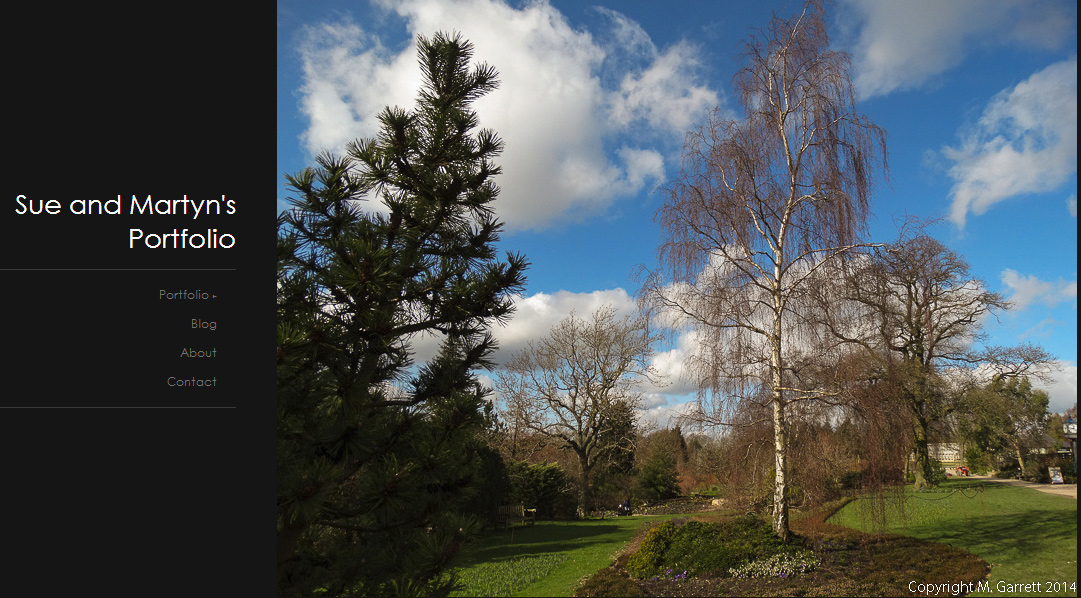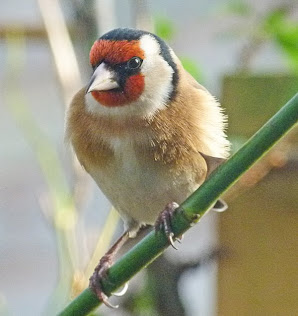We have taken part in the RSPB Big Garden Birdwatch for quite a few years now and have kept records of our counts since 2012 and thought it would be interesting to compare the results.
Although the house sparrow numbers have fluctuated a little, the sparrow has been a constant visitor. The number recorded doesn't really reflect the actual numbers as they usually arrive in a large groups that scatter around the garden and are constantly on the move. This makes counting really tricky so we have erred on the side of caution when recording the number of visitors.
The starlings also usually arrive in a squabbling mass to make counting tricky but this time we only had one solitary individual, (very unusual for starlings) and so counting was easy.
Spotting a coal tit during the count is very hit and miss and this year we didn't record any and the collared doves also failed to show up. Both are regular visitors.
One worrying absentee from our garden is the goldfinch. We usually have a constant stream of them to feeders. This year since back in spring we have only seen the occasional visitor and none of the usual hoards of juveniles.
Robins are almost a constant presence in the garden and can be guaranteed to show up.
Blackbirds too are usually in evidence but this year not in the numbers we are used to and they don't seem to be as early to spot a newly replenished bird table. I hope that this means they are finding plenty of natural food especially slugs and snails.
Great tits and blue tits can also always be relied upon to turn up for the count. A flock of long tailed tits frequently visit the feeders and this year they sent representatives to actually managed to put in an appearance during the count. Not the usual number though where the best way of assessing their numbers is to count tails.
This year we didn't record any collared doves although we still see them in the garden regularly. Wood pigeon numbers, however have been fairly constant across the years we have recorded.
Another regular visitor is the dunnock, it's often seen foraging on the ground but will also venture onto the bird table.
Chaffinches although I wouldn't class as regulars often seem to make it to the count.
Unlike in 2012, when we recorded a bullfinch and a sparrowhawk, no surprise visitors made it into the count this year.
The total number of birds counted this year has dropped considerably which coincides with our general observations. I hope that the low numbers are due to the birds finding plenty of natural food around rather than a decline in the population.








































It's interesting to see the variation in different years. I wonder why the big decrease in starlings?--though I would be happy. Never liked their piggish ways at our feeders.
ReplyDeleteStarlings have lovely markings when the sun shines on them though, Sue. I do like them in spite of their bad manners :-)
DeleteGoodness, did you actually get a sparrowhawk in the garden? It's a wonder anything else visited during the hour. Your results look as though your numbers are fairly constant, one year there may be less of something but they're back again the following year. I know people who tally up the number of birds they see in the garden over the hour whereas you're supposed to record the highest number seen at one time during that hour, I think the rspb make it pretty clear, don't they? I'm still getting plenty of goldfinches in the garden, though I got a new niger seed feeder and they're not eating from it at all. They always make straight for the niger seed and I've seen them on the feeder but the seed isn't going down at all. I'm beginning to wonder if the slots are big enough to allow the seed out. It's a Gardman, so a decent make. The photos in this post are fabulous, I really enjoyed looking at them all.
ReplyDeleteWe do get sparrowhawks visiting from time to times, Jo. One juvenile once sat just outside the window on a plant pot plucking something and cheekily staring in at us. We have had them sitting on the greenhouse and in a crab apple tree but often they just fly through - we have less often has a kestrel - usually sitting on the bird bath. The photos and videos of some sparrowhawk visits are on this page of our website
DeleteWe have niger seeds ad sunflower hearts which the goldfinches used to flock to but not any more. The niger seed dispenser doesn't have slots. The RSPB ones have holes like normal seed feeders - we found that the slotted ones didn't work.
Excellent photos and a good number of varieties in your count! Well done and probably a good thing the sparrowhawk wasn't there!
ReplyDeleteYes I do have mixed feelings about their visits Belinda.
DeleteThe birds I see most often are the same ones as you, but I have on occasion had visits from Wren, Blackcap, Nuthatch, Green Woodpecker, Spotted Woodpecker, Field Fare and Greenfinch - and of course Jays and Thrushes. Oh, plus Rooks and Jackdaws. They probably wouldn't turn up on cue for a one-hour slot though!
ReplyDeleteWe sometimes get great spotted woodpeckers too, Mark and we have had a redpoll once we also have a wren visits frequently . We never see jays in the garden. I wish we did!
DeleteWe have a large poster pinned in my office with the most common birds in the north east & every time we see a new one in the garden, my daughter rushes to see what it is. She is beginning to recognize some of them by sight (as am I!) and it's so funny when my husband says "There's a bird at the feeder" and she pipes up "Oh, that's a ..." :)
ReplyDeleteWe are gradually learning to recognise water birds, Margaret. Not that we get any in the garden :-)
DeleteWe have had less birds visit the garden this year, also during the bird watch hour. I think the mild weather and high winds are effecting the birds. I believe the RSPB would have a more accurate result if they allowed the survey to be over the whole weekend.
ReplyDeleteYou're right Brian I guess they RSPB think that people will give up an hour but if they made it longer they would have less people responding. I don't see why though if people had the choice it would spoil their research. They could ask how long were you watching couldn't they?
DeleteI do hope the goldfinches return before too long. We've seen a few here, and also lots of long-tailed tits, including two which turned up for the birdwatch. Nothing unusual this year though.
ReplyDeleteWe really miss the goldfinches, CJ I hope they come back too.
DeleteExcellent photos Sue :) I've been so out of touch with all things garden related that I didn't even realise the bird watch had arrived :(
ReplyDeleteI've actually seen a return of the greenfinches this year and as usual the Blue Tits and Great Tits are in abundance :) I also think we muct have your Starlings here too, I've never seen so many.
Thank you, Linda. We used to get lots of greenfinches but see very few nowadays. I think they suffered from that dreadful finch disease around here.
DeleteLovely photos Sue.. we have lots of chaffinches in the garden at the moment. We did have lots of sparrows all through last year but not many about at the moment. Blackbirds breed well around here too there are usually several in the garden. I hope your goldfinches return.. last year we had quite a lot and many juveniles too, we still get the odd one or two and 1 did actually turn up to be counted.
ReplyDeleteThank you, Julie. We just get one or two chaffinches but like in your garden the blackbirds breed very well and we often get a lots of juveniles. Often it is a blackbird war zone around here
DeleteSue, you did a good job photographing those birds. I've not seen such birds here, but they are indeed lovely.
ReplyDeleteThank you, Elsie. Also thank you for visiting and commenting. I've had a look at some of your photographs and you take some lovely images.
DeleteNice to follow how many have visited over the years. You do get a good number of birds and I love the photos. I haven't had goldfinches in my garden for a while either and I miss the greenfinches. They seem to have sadly declined.
ReplyDeleteWe used to have lots of greenfinches too, Annie but I think the finch disease hit them very badly. I hope the bad weather hasn't hit the goldfinch population this time. They are such pretty birds to have on the feeders.
DeleteGreat numbers of visitors Sue, I guess some visitors would exclude others so possibly just as well the hawks stay out of the garden most of the time! I have recently learned to recognise the dunnock and I have a couple of frequent visitors in my garden. They pick up anything dropped from the hanging birdfeeders and also go on the bird table I have on the ground. Cute little birds. But guess who I caught today munching away on the mealworms on the bird table? A cat! There are lots of cats in the neighbourhood and this was a little black one that lives across the street. I didn’t know cats would eat mealworms – seems I am feeding birds, squirrels and now also cats with my bird feed!
ReplyDeleteI would have never believed that cats would eat mealworms, Helene. It's preferable to them eating the birds though isn't it? Dunnocks are often overlooked little birds, many people seem to just think of them as another sparrow and they see them. The fact that they are sometimes referred to as hedge sparrows doesn't help despite them being absolutely no relation to the sparrow family they certainly are not any kind of finch but are members of the thrush family. They sing beautifully in the spring. I hope they are very careful and keep a watch out for those cats.
DeleteSue, I see you counted birds less than in other years. What happened with birds? Here is the same: I watched only sparrows, tits, magpies and jay. Maybe the climate changes and birds fly away?
ReplyDeleteI love your photos, especially this one of robin!
I don't know whether the mild winter means they can find food easily elsewhere, Nadezda or the strong wonds that we are being constantly battered by have affected them. I hope they come back!
DeleteAlways hard to tell whether the fall in numbers is because they are happy elsewhere or because of the general decline. I suppose that is why the surveys are so valuable, it gives a good national picture of trends and unusual events.
ReplyDeleteIt is a bit of a mystery, Janet. I like to think it is the former.
DeleteOoh, great close-ups sue. It's interesting to see your yearly comparisons. We had a good result for us - 2 collared doves, 3 wood pigeons, 2 blackbirds, 2 bluetits, 2 great tits, 2 dunnocks and a chaffinch and robin. The dunnocks are checking out our neighbour's garden. They nested in her garden last year but that bush has been heavily pruned and is too open, but hopefully a different one will suit them
ReplyDeleteThanks, Lou. The birds will al start pairing up soon won't they?
Delete